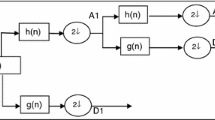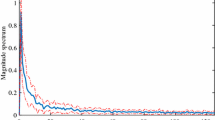Abstract
Mental task categorization using single/limited channel(s) electroencephalogram (EEG) signals is crucial for designing portable brain–computer interface and neurofeedback systems. However, EEG signals are corrupted with ocular artifacts and muscle artifacts, which degrade the robustness of existing features resulting inaccurate categorization of mental tasks. Therefore, in this paper, we propose a real-time mental task categorization method using stationary wavelet transform (SWT)-based novel discriminant features and different classifiers. It consists of four major stages: EEG signal decomposition and reconstruction using SWT into subbands; computation of proposed relative subband energy features (i.e., total energy of all subbands(\(E_t\)), relative energy of each subband k (\(E_{r(k)}\)) and sum of relative energy pair ratio and difference); significant feature selection; classification using seven classifiers. The robustness of the proposed method is evaluated using two publicly available datasets and in-house dataset recorded using single-channel EEG headset. Performance evaluation results show that the proposed method with support vector machine classifier achieves the highest average subject-dependent accuracy of 98% for classification of mental/mental and baseline/mental tasks. Extensive comparative performance analysis depicts the superiority of the proposed method as compared to existing techniques in terms of accurate categorization of mental tasks, computational complexity, EEG processing length and robustness under artifact-contaminated EEG signals.











Similar content being viewed by others
Data Availability
The recorded-in-house database is available on request from authors.
References
D. Acharya et al. Comparative analysis of feature extraction technique on EEG-based dataset, in Soft Computing for Problem Solving (Springer, Singapore, 2021), pp. 405–416
I. Aliyu et al., Selection of optimal wavelet features for epileptic EEG signal classification with LSTM. Neural Comput. Appl. 1–21 (2021)
Z.A.A. Alyasseri et al., The effects of EEG feature extraction using multi-wavelet decomposition for mental tasks classification, in Proceedings of the International Conference on Information and Communication Technology (2019), pp. 139–146
M. Arsalidou, M.J. Taylor, Is 2+2=4? Meta-analyses of brain areas needed for numbers and calculations. Neuroimage 54, 2382–2393 (2011)
H. Azami, J. Escudero, Combination of signal segmentation approaches using fuzzy decision making, in 2015 37th Annual International Conference of the IEEE Engineering in Medicine and Biology Society (EMBC) (Milan, 2015), pp. 101–104
R. Chen et al., Autoregressive models for matrix-valued time series. J. Econ. 222(1), 539–560 (2021)
S. Dutta et al., Automated classification of non-motor mental task in electroencephalogram based brain–computer interface using multivariate autoregressive model in the intrinsic mode function domain. Biomed. Signal Process. Control 43, 174–182 (2018)
E. Ergün et al., A new evolutionary preprocessing approach for classification of mental arithmetic based EEG signals. Cognit. Neurodyn. 14, 1–9 (2020)
T. Fawcett, An introduction to ROC analysis. Pattern Recogn. Lett. 27(8), 861–874 (2006)
A. Goldberger et al., PhysioBank, physioToolkit, and physioNet: components of a new research resource for complex physiologic signals. Circulation 101(23), 215–220 (2003)
L. Guo et al., Classification of mental task from EEG signals using immune feature weighted support vector machines. IEEE Trans. Magn. 47(5), 866–869 (2010)
A. Gupta et al., On the utility of power spectral techniques with feature selection techniques for effective mental task classification in non-invasive BCI. IEEE Trans. Syst. Man Cybern. Syst. 51, 1–13 (2019)
A. Jaramillo-Jimenez et al., Resting-state EEG alpha/theta ratio related to neuropsychological test performance in Parkinson’s Disease. Clin. Neurophysiol. 132(3), 756–764 (2021)
Z.A. Keirn, J.I. Aunon, A new mode of communication between man and his surroundings. IEEE Trans. Biomed. Eng. 37(12), 1209–1214 (1990)
N.S. Kumar et al., Detection of autism in children by the EEG behavior using hybrid bat algorithm-based ANFIS classifier. Circuits Syst. Signal Process. 39(2), 674–697 (2020)
Y. Kwak et al., FGANet: fNIRS-guided attention network for hybrid EEG-fNIRS brain–computer interfaces. IEEE Trans. Neural Syst. Rehabil. Eng. 30, 329–339 (2022)
C.J. Lin, M.H. Hsieh, Classification of mental task from EEG data using neural networks based on particle swarm optimization. Neurocomputing 72(4–6), 1121–1130 (2009)
S. Mallat, A Wavelet Tour of Signal Processing: The Sparse Way (Academic, New York, 2008)
M.L. McHugh, Interrater reliability: the kappa statistic. Biochemia Medica 22(3), 276–282 (2012)
W. Mendenhall et al., Introduction to Probability and Statistics, 12th edition, Chapter 10, pp. 404–406
M. Merah et al., R-peaks detection based on stationary wavelet transform. Comput. Methods Programs Biomed. 121(3), 149–160 (2015)
P.B.C. Miranda, R.B.C. Prudêncio, Active testing for SVM parameter selection, in The 2013 International Joint Conference on Neural Networks (IJCNN) (2013), pp. 1–8
S. Ng, P. Raveendran, Enhanced \({\mu }\) rhythm extraction using blind source separation and wavelet transform. IEEE Trans. Biomed. Eng. 56(8), 2024–2034 (2009)
S. Noshadi et al., Selection of an efficient feature space for EEG-based mental task discrimination. Biocybern. Biomed. Eng. 34(3), 159–168 (2014)
E.W. Nugroho, B. Harnadi, The method of integrating virtual reality with brainwave sensor for an interactive math’s game, in 2019 16th International Joint Conference on Computer Science and Software Engineering (JCSSE) (Chonburi, Thailand, 2019), pp. 359–363
R. Palaniappan, Utilizing gamma band to improve mental task based brain–computer interface design. IEEE Trans. Neural Syst. Rehabil. Eng. 14(3), 299–303 (2006)
H. Qayyum et al., Facial expression recognition using stationary wavelet transform features. Math. Probl. Eng. 2017 (2017)
M.M. Rahman et al., An efficient feature extraction scheme for classification of mental tasks based on inter-channel correlation in wavelet domain utilizing EEG signal. Biomed. Signal Process. Control 61, 102033 (2020)
M.T. Sadiq et al., Evaluation of power spectral and machine learning techniques for the development of subject-specific BCI, in Artificial Intelligence-Based Brain–Computer Interface (Academic Press, 2022), pp. 99–120
M. Saini, U. Satija, An effective and robust framework for ocular artifact removal from single-channel EEG signal based on variational mode decomposition. IEEE Sens. J. 20(1), 369–376 (2019)
M. Saini, U. Satija, M.D. Upadhayay, Variational mode decomposition based mental task classification from electroencephalogram, in 2020 IEEE 17th India Council International Conference (INDICON) (2020), pp. 1–7
M. Saini, U. Satija, M.D. Upadhayay, One-dimensional convolutional neural network architecture for classification of mental tasks from electroencephalogram. Biomed. Signal Process. Control 74, 103494 (2022)
M. Saini, U. Satija, Effective automated method for detection and suppression of muscle artefacts from single-channel EEG signal. IET Healthcare Technol. Lett. 7(2), 35–40 (2020)
U. Satija et al., Performance study of cyclostationary based digital modulation classification schemes, in 2014 9th International Conference on Industrial and Information Systems (ICIIS) (Gwalior, 2014), pp. 1–5
U. Satija, B. Ramkumar, M.S. Manikandan, Real-Time signal quality-aware ECG telemetry system for IoT-based health care monitoring. IEEE Internet Things J. 4(3), 815–823 (2017)
U. Satija, B. Ramkumar, M.S. Manikandan, Automated ECG noise detection and classification system for unsupervised healthcare monitoring. IEEE J. Biomed. Health Inform. 22(3), 722–732 (2017)
D.F. Schmidt, E. Makalic, Estimating the order of an autoregressive model using normalized maximum likelihood. IEEE Trans. Signal Process. 59(2), 479–487 (2011)
M. Sekiya et al., Linear logistic regression for estimation of lower limb muscle activations. IEEE Trans. Neural Syst. Rehabil. Eng. 27(3), 523–532 (2019)
A. Sen et al., Binarization with boosting and oversampling for multiclass classification. IEEE Trans. Cybern. 46(5), 1078–1091 (2016)
P.K. Sethy et al., Machine learning based classification of EEG signal for detection of child epileptic seizure without snipping. Int. J. Speech Technol. 8, 1–12 (2021)
F.A. Shargie, Multilevel assessment of mental stress using SVM with ECOC: an EEG approach. EngrXiv (2019)
L.D. Sharma et al., Mental arithmetic task load recognition using EEG signal and Bayesian optimized K-nearest neighbor. Int. J. Inf. Technol. 13(6), 2363–2369 (2021)
P. Singh et al., Fourier-based feature extraction for classification of EEG signals using EEG rhythms. Circuits Syst. Signal Process. 35(10), 3700–3715 (2016)
S. Sophia et al. Real time cognitive state prediction analysis using brain wave signal, in IOP Conference Series: Materials Science and Engineering. IOP Publishing, vol. 1055 (2021), p. 1
L. Sörnmo, P. Laguna, The electroencephalogram—a brief background. Bioelectric. Signal Process. Cardiac Neurol. Appl. 1, 25–53 (2005)
M. Suchetha et al., Sequential convolutional neural networks for classification of cognitive tasks from EEG signal. Appl. Soft Comput. 111, 107664 (2021)
A. Taruttis et al., Multiscale multispectral optoacoustic tomography by a stationary wavelet transform prior to unmixing. IEEE Trans. Med. Imaging 33(5), 1194–1202 (2014)
K.P. Thomas, A.V. Prasad, EEG-based biometric authentication using gamma band power during rest state. Circuits Syst. Signal Process. 37(1), 277–289 (2018)
C.A. Valentim et al., Fractal methods and power spectral density as means to explore EEG patterns in patients undertaking mental tasks. Fractal Fractional 5(4), 225 (2021)
Q. Wang, O. Sourina, Real-time mental arithmetic task recognition from EEG signals. IEEE Trans. Neural Syst. Rehabil. Eng. 21(2), 225–232 (2013)
Y. Wang et al., An efficient method to detect sleep hypopnea-apnea events based on EEG signals. IEEE Access. 9, 641–650 (2021)
L. Xia, A.S. Malik, A.R. Subhani, A physiological signal-based method for early mental-stress detection. Biomed. Signal Process. Control 46, 18–32 (2018)
M. Zeynali, H. Seyedarabi, EEG-based single-channel authentication systems with optimum electrode placement for different mental activities. Biomed. J. 42(4), 261–267 (2019)
L. Zhang et al., Improving mental task classification by adding high frequency band information. J. Med. Syst. 34(1), 51–60 (2010)
Y. Zhang et al., Combined feature extraction method for classification of EEG signals. Neural Comput. Appl. 28(11), 3153–3161 (2017)
W. Zhu, X. Liu, M. Xu, H. Wu, Predicting the results of RNA molecular specific hybridization using machine learning. IEEE/CAA J. Automatica Sinica 6(6), 1384–1396 (2019)
T. Zikov et al., Quantifying cortical activity during general anesthesia using wavelet analysis. IEEE Trans. Biomed. Eng. 53(4), 617–632 (2006)
I. Zyma et al., Electroencephalograms during Mental arithmetic task performance. Data 4, 14 (2019)
Author information
Authors and Affiliations
Corresponding author
Additional information
Publisher's Note
Springer Nature remains neutral with regard to jurisdictional claims in published maps and institutional affiliations.
Rights and permissions
About this article
Cite this article
Saini, M., Satija, U. & Upadhayay, M.D. Discriminatory Features Based on Wavelet Energy for Effective Analysis of Electroencephalogram During Mental Tasks. Circuits Syst Signal Process 41, 5827–5855 (2022). https://doi.org/10.1007/s00034-022-02057-9
Received:
Revised:
Accepted:
Published:
Issue Date:
DOI: https://doi.org/10.1007/s00034-022-02057-9




